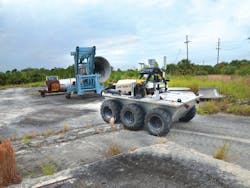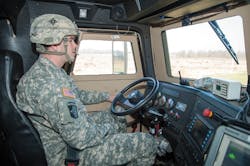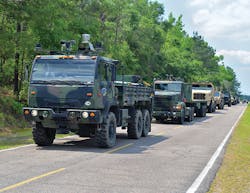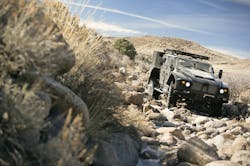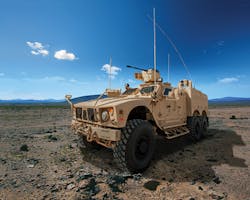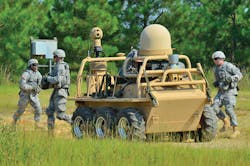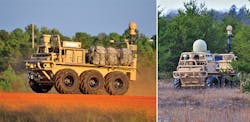The latest enabling technologies for machine autonomy are yielding applications ranging from optionally driven land vehicles and military trucks that follow on their own, to robotic exoskeletons that give warfighters super powers.
By J.R. Wilson
Predictions during the past century had it that aviation would dominate future combat, that tank warfare has become obsolete, and that "boots on the ground" are only necessary for post-combat mop-up operations. So far, those predictions have proven less than accurate, despite the importance of air dominance and asymmetric insurgent warfare in which tanks have very limited roles.
Electronic warfare (EW) and cyber warfare also are growing in importance, offensively and defensively.
At the same time, however, infantry remains the backbone of U.S. military power once an enemy has been engaged, no matter the size, shape, location, or environment of the battlespace. Even so, U.S. Army and Marine Corps warfighters in 2016 bear little resemblance to their predecessors of even 20 years ago.
It is an evolution - if not a revolution - that will continue into the foreseeable future, with greater reliance on robotic systems to help the human warrior accomplish his mission more quickly, efficiently, and successfully with reduced personal endangerment or collateral damage.
Ground robotics are older than most people realize. Nazi Germany and the Soviet Union deployed rudimentary, tele-operated robots during World War II; Germany had the wire-controlled Little Goliath, while the Red Army fielded two battalions of radio-controlled "teletanks."
Soviet forces used the teletanks against Finland in the "Winter War" of 1940, but retired them after the two nations signed a treaty. Turns out the teletanks lacked protective armor or adequate armament to go against German tanks.
Nazi armed forces used the Goliath more widely throughout the war to destroy Allied tanks, disrupt infantry formations, and blow up bridges and buildings with the 220-pound high explosives it carried. Designed to self-destruct during its mission, the 5-foot-long, 3-foot-wide "beetle tank" (as it was called by the Allies) had a range of only 2,130 feet, the length of its longest control wire. That combined with its high cost, slow speed, poor ground clearance, vulnerable control cables, and thin armor to limit the robot's success, leading to its ultimate demise with the defeat of Nazi Germany.
History's lessons
Having observed the German and Soviet efforts, experts at the U.S. Army Tank Automotive Research, Development, and Engineering Center (TARDEC) in Warren, Mich., began researching ground robotics in the 1950s, starting with Little David. The purpose-built, tele-operated 4- wheel drive platform about 6 feet long, 2 feet wide, and 2 feet high, was demonstrated with a weapons system, a camera for situational awareness, and casualty evacuation capability.
To many, combining "military" and "robotics" conjures visions of Hollywood's The Terminator - and for some other nations, especially Russia, that is truer than it is for the U.S. and most of its allies. While the Russians have made no secret of their desire to field an army of lethal autonomous robots, the U.S. continues to move forward on semi-autonomous, man-in-the-loop systems that significantly improve the range, firepower, situational awareness, and overall capabilities of soldiers and Marines.
One of the key elements is man-ned and unmanned teaming, with humans and robots working seamlessly as partners, assisted by unmanned air and ground platforms working together, just as manned air and ground systems do today.
"During the past 15 years of war in Southwest Asia, you saw commercial robots being brought in, mostly fixed on explosive ordnance disposal," says Robert Sadowski, Army Chief Roboticist at TARDEC. "But we've come a long way since then. In response to the IED [improvised explosive device] challenge, we started looking at how to automate logistics. So the technologies we've been working on are how to take an old analog Army truck and turn it into not only a digital vehicle with all the modern safety features (auto braking, object detection, etc.) but put an autonomy kit on top of that - AMAS [Autonomous Mobility Applique System].
"If I have a convoy, I can remove the human drivers from trucks carrying ammo and other explosives," Sadowski continues. "That's fairly well along, with spinout 1.2 going to Army demonstration this fall. There will still be a driver in the lead, but using leader-follower technology, we can remove drivers from the others. Those vehicles run about 50 to 100 meters apart, so if one truck is hit, it doesn't take out the whole convoy. You also have to 'sensor' the vehicle in front of you to keep the proper pace and spacing. And if you need fewer soldiers to do that job, you can increase their presence elsewhere."
Finding explosives
The first major 21st Century U.S. efforts in ground robotics centered on the need to inspect vehicles for explosives at security checkpoints in Iraq and Afghanistan; locate - and later deal with - improvised explosive devices (IEDs); and inspect abandoned buildings, caves, and the other side of obstacles without endangering human warfighters.
Those were all small robots, some tethered, capable of carrying only minimal sensor payloads or manipulator arms, yet their value soon made them integral parts of small combat units. Throughout the wars in Southwest Asia, however, military, academic, and industry researchers worked on a wide range of robotic concepts, including:
- small "dogs" or "mules" to follow humans on patrol or in combat, carrying extra supplies as well as reducing the load carried by the warfighters themselves;
- mid-size vehicles (in the same general size as a Humvee) to support larger unit logistics and provide medevac capability, improved communications, and sensor technologies - and possibly to serve as weapons platforms;
- unmanned tanks and other armored vehicles for first engagements with the enemy; and
- unmanned logistics trucks to remove human convoy drivers (and their guards) from harm's way.
Infantry warfighters today must carry much heavy equipment onto the battlefield, so TARDEC researchers have worked on projects like the Squad Mission Support System (SMSS), Ground Unmanned Support Surrogate (GUSS), Multipurpose Unmanned Tactical Transport (MUTT), and a squad multipurpose equipment transport called Protector to help them out, says TARDEC's Sadowski.
The SMET enables infantrymen to take a lot off his back, for example, which reduces fatigue and increases the amount of equipment he can carry. Experts have field tested the SMET in the Arctic and the jungle, which revealed that some things work better than others in different places.
Helping warfighters
"We also have a platform that can carry more than just the soldier's load, such as weapons, giving a small unit greater fire power than they've ever had," Sadowski says. We've been doing testing with that, all man-in-the-loop, that allows the robot to go around the corner and lay down fire rather than risking a human warfighter. But they need to be easy to operate, so the soldier can view the robot as a teammate."
Autonomy is a controversial element in the future of combat robotics, from technological and operational perspectives. While other nations are pursuing fully or semi-autonomous weapons systems, the U.S., so far, has elected to maintain a man-in-the-loop requirement for "pulling the trigger," focusing its autonomous developments in the areas of guidance and navigation.
"Autonomous systems are not functionally reliable in terms of performing basic tactical tasks in relevant environments," warns Dan Rogers, autonomous program manager at General Dynamics Land Systems in Sterling Heights, Mich. "Even if the tasks are simple, they must be performed to standard in relevant conditions. The problem with autonomous systems in a tactical setting is, if the utility ends up being less than advertised, the burden of owning, operating, and maintaining the autonomous system overwhelms the benefits of the added utility. The primary challenges associated with tactical mobile ground robotics are perception and communications; perception is the weakest link in the technology, [but] communications is a close second.
"The key to effective decision-making is intelligence - and machine learning is the proper perception to feed those automated thinking machines," Rogers continues. "Without perception, the system won't perform in its intended environment. The sensor technology investment seems to be a big technology oversight; the commercial world is using inexpensive camera technology and doing wonders with that modality along with some radar technology. However, development of proper environment sensing in nighttime operations in all-weather in unstructured environments is not keeping pace. They are necessary for successful operations in a tactical environment."
Open-systems architectures
The Lockheed Martin Mission Systems & Training segment has a long history with unmanned ground vehicles (UGVs), unmanned underwater vehicles (UUVs), and unmanned aerial vehicles (UAVs), including unmanned helicopters as well as hand, bungee, and pneumatic-launched unmanned aircraft - all oriented toward tactical use. Lockheed Martin also has been a proponent of open-systems architectures, from software to components to control stations.
"Research and development has been driven by open-system architecture, modular so we can maintain the newest and greatest payload capabilities, in the air and on the ground, so the user eventually will be able to use a variety of different platforms for different missions with a common control system," says Jay McConville, business development director for unmanned integrated systems at Lockheed Martin.
"We want to have a common architecture and software we can apply to a number of different hardware applications, which we categorize under a robotic common software control architecture that runs on a number of different platforms, from handheld to larger," McConville says. "That also reduces training requirements for the user. And when you have that architecture, you can add tools to it, sort of like apps on a cell phone."
Lockheed Martin Robotics & Intelligent Systems Advanced Technology Laboratories (ATL) was one of the companies involved with the robotic land challenge of the U.S. Defense Advanced Research Projects Agency (DARPA), developing technologies that went into a small car and showed it could be driven, obey traffic rules, avoid pedestrians, etc.
"We then developed the Squad Mission Support System using the same set of technologies, enabling it to follow soldiers around the battlefield and carry supplies," notes Kingsley Fregene, ATL's robotics group leader. "We're also part of DARPA's Warrior Web program to assist soldiers who start having muscular-skeletal injuries from carrying heavy loads. So we developed a soft exo-suit, almost like a vest, that can be worn under the uniform to provide additional support to reduce those types of injuries. It covers the torso and down to the knee joints, using different attachments."
Aids to navigation
"Another issue ground soldiers encounter is fratricide, so we developed a UAV-based technology that provides navigation aiding to help ground soldiers determine their location within an operational space and helps the squad leader know where all friendly soldiers are in that immediate area," Fregene continues. "That operates from small, organic squad micro-UAVs that also can carry a camera, allowing the operator to see across a wide area. These rotate at 10 times or more per second, enabling 360-degree imagery of any area without any complex systems. That provides good situational awareness."
Lockheed Martin Missiles & Fire Control in Orlando, Fla., has been involved with robotic programs for at least the past 15 years, including the Consolidated Automated Support System (CASS) and its recent successor, eCASS, and capability-advanced demonstrators. The company's current robotic focus is on next-generation systems like Autonomous Mobility Applique System and Squad Mission Support System - basically, putting autonomous and semi-autonomous capability on Army vehicles to increase the safety of the vehicle and the soldiers in it by reducing accidents, along with more advanced features, such waypoint-following and leader-follower.
"Within the military, AMAS is to feed transitions to other systems, not go into production itself," says Joe Zinecker, Lockheed Martin's director of combat maneuver systems. "The Army is developing several programs of record into which AMAS will fit, such as route clearance and interrogation systems, beginning with tele-operated, but eventually fully autonomous vehicles to do counter-IED ops without having a solder sitting in the vehicle.
"The Army also is implementing AMAS in various stages onto a number of logistics vehicles," Zinecker continues. "So far, we have integrated AMAS into eight different vehicle types. The next step is for the Army to select one of those and retrofit it onto those vehicles. The Army is still deciding what level of AMAS to put on those heavy vehicles, from simple driver warning systems to driver-assist systems to leader-follower to fully autonomous capabilities."
It is unlikely U.S. unmanned systems will operate with full independence in the foreseeable future. Instead, the military services are working to make robots and humans seamlessly integrated teammates.
"The Army has started to work on manned and unmanned teaming with UAVs and we expect them to do the same with UGVs," says Brad Curran, defense analyst with market researcher Frost & Sullivan. "Increased situational awareness and ISR for manned ground vehicles is definitely a trend for the future, such as updating Stryker, Bradley, etc."
More computing power
"They need more computing power, more raw power, and the ability to distribute it, because all these platforms will have better electro-optical sensors, active protection measures, counter rocket and mortar systems, improved situational awareness, and communications ability," Curran continues. "So VICTORY-based standard- ization of connector and power assets will enable them to easily integrate advanced sensors as they come online, including things we haven't even thought about yet but will be available for upgrades in the 2020s."
Another area of military robotization involves enhancing the capabilities of the individual warfighter through mechanical augmentation, such as exo-skeletons. Already in use by industry and some military logistics facilities, these are the real-world version of the huge robotic skeleton the lead character used to battle a giant adversary in the movie Aliens.
Lockheed Martin Corp. developed the Human Universal Load Carrier (HULC) for the Army's Natick Soldier Research Development and Engineering Center. In a series of tests, Natick experts evaluated the potential for exoskeleton technology to alleviate strain and fatigue for soldiers who carry heavy loads over long distances. Further innovations are building on HULC and related efforts to produce lighter and more user- friendly exoskeleton technology.
The enabling technologies that have turned combat robotics from science fiction to military integration in the past two decades largely have come from the commercial world, especially automotive and communications. Those, in turn, have been based on improvements in computing speed, power, and miniaturization.
Those also will be the keys to future advances, along with stronger, lighter materials, better use of broadband, greater data compression, sensor fusion at the source, secure and fully integrated networking, better and more intuitive man/machine interfaces, comprehensive training - from platoon-level users to senior commanders - and faster acquisition protocols.
Areas for improvement
Industry officials generally agree most needed advancements in technology fall into three main categories:
- Developing efficient electronics that can be packed into a small form factor for improved SWAP. While it is now possible to put together processing power that only a few years ago would have been far heavier and larger, further advances are needed for even smaller, manpackable robotics.
- Building on the remarkable progress already being deployed in autonomy algorithms, which previously saw limited infantry use due to a lack of processor capability; those have improved dramatically in recent years, a trend that is expected to continue, enabling better algorithms to provide advanced robotic capabilities ground warfighters.
- Critical improvements in sensors. Ten years ago, DARPA's Open Chal-lenge saw vehicles using large LIDAR systems to measure distance and speed. Today, that same capability or more is available in a cell phone. With smaller, faster, more powerful processors, not only are individual sensors improving, so is the ability to place multiple sensors on the same platform, along with the computing power to convert raw data into useful information before transmitting it on the network, thus putting far more capability into the hands of the warfighter.
While commercial developments will remain the leading source of such advances, there are many areas where civilian and military requirements differ substantially.
"Most of the requirements we've been getting are in the operational realm, such as being able to contend with severe terrain and austere conditions, requirements far different from those leading to self-driving cars on public highways, where you have a known infrastructure and good communications," says John Beck, chief principal engineer for unmanned systems at military vehicle designer Oshkosh Defense.
"So intelligent control and interpretation of the environment, requiring a lot of improved processing, are needed," Beck continues. "Our detection can filter out environmental clutter, such as vegetation, so the vehicle's motion planner can decide how to negotiate the terrain and environmental hazards. On top of that, using machine-learning techniques, it can determine between airborne obscurance, vegetation, etc. - you can drive over some vegetation, but avoid trees. That has been a big focus for our approach to autonomy."
Future ground warfare - as with air and naval combat - will be nearly unrecognizable even for recent veterans. At the same time, military leaders should not try to oversell the technology or ignore lessons from past conflicts. "Maybe every squad doesn't get a big robot, but has a lot of smaller robots or specialized robotic units or heavy robotic units to absorb initial combat power," says TARDEC's Sadowski. "The nature of combat may be changed by having more attritable assets, but you still need people to seize and hold territory."
One way to see into the future is to start with building enough unman- ned platforms for a platoon and learn what can or can't be done, Sadowski says. How, and how quickly, that can and will be done also will determine how the U.S. advances its robotic capabilities, in concert with allies and in conflict with adversaries.
